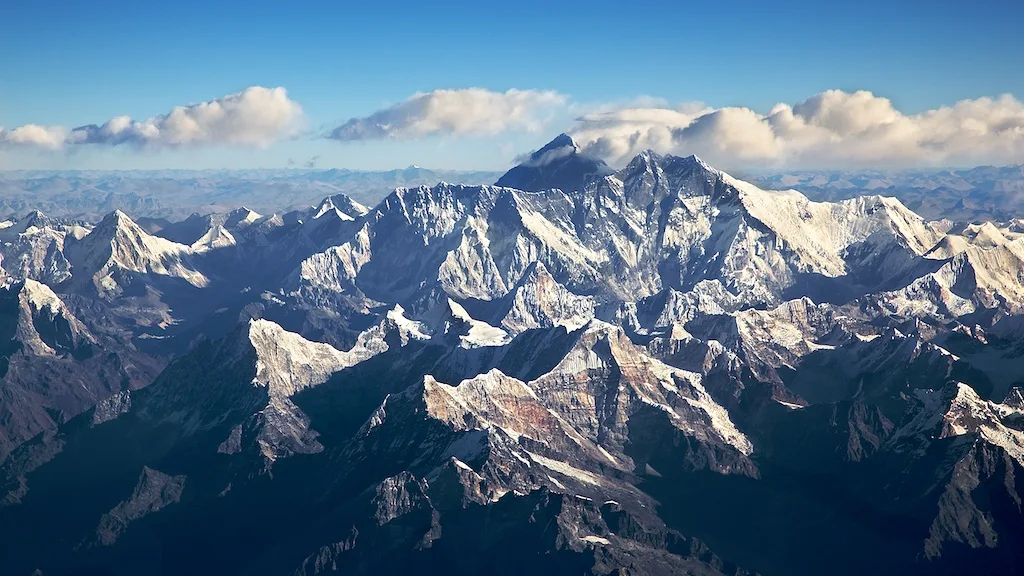Everest is known worldwide as the highest peak on Earth, a meeting place and adventure for climbers and an example of natural beauty. The Nepalese call it Sagarmāthā, the Chinese know it as Zhūmùlǎngmǎ Fēng, and the Tibetans have named it Chomolungma. For most Western people, it is Everest, a name given to it in honor of George Everest, a surveyor who studied the geography of India during the 19th century.
 |
| Mount Everest |
Characteristics
There is some confusion regarding the height of Everest. It is completely true that its peak is the highest point on the planet, extending several meters above sea level, but it is not the largest or highest mountain of all, if one considers that there are others of greater amplitude and even higher. below sea level. Mauna Kea, for example, is a volcanic mountain that measures more than 10,000 meters high from its base, located on the seabed.
The Mount Everest is part of the Himalayas, located in Southeast Asia, between the Indian subcontinent and the rest of Asia. Sitting above Nepal and Tibet (China), it rises 8,848-8,850 meters above sea level and its complex covers an area of approximately 594,400 km2. It exhibits a shape similar to that of a three-sided pyramid. Due to its height, the air in the upper parts lacks oxygen and the area is whipped by strong winds in the midst of freezing weather.
 |
| Mount Everest |
Its summit or summit consists of very hard snow surrounded by another layer of snow that can be reduced or increased. It is a little higher in September and in May its height decreases slightly. The temperature varies with the seasons; in January it can reach -36 ºC while in July, in midsummer, it reaches around -19 ºC. The monsoon season, which runs from June to September, produces intense storms with winds of up to 285 km / h. On the other hand, there the atmospheric pressure is 30 percent of that found at sea level.
A few meters below the summit is the "death zone", so called because the lack of oxygen and the very low temperatures have caused several deaths of mountaineers. As the altitude decreases, the temperature rises and the snow and ice cover becomes thinner until the mountain rock is better seen.
Training
Everest is composed of several folded layers of sedimentary and metamorphic rocks covered by ice and snow, stacked over many millions of years. Talking about the formation of the mountain inevitably leads towards the formation of the Himalayas, being part of it.
It is first necessary to go back to the time when Pangea was a single supercontinent on Earth, during the late Paleozoic and early Mesozoic. About 175-180 million years ago its surface began to fragment as a result of the internal movements of the planet, and towards the Jurassic two great land masses named Laurasia and Gondwana appeared. The latter was made up of present-day South America, Africa, Antarctica, Madagascar, Australia, the Arabian Peninsula and the Indian subcontinent. Laurasia included what is now North America, Europe, and Asia.
 |
| Mount Everest |
From this perspective, the Indian subcontinent was separated at that time from Asia, years later the subcontinent, already separated from Africa and other masses, began to move north until it collided with Asia. The collision caused the indica plate to subduct; the sinking of one plate under another due to differences in pressure and temperature was what caused the earth's crust to wrinkle and the famous mountain range was formed. Everest is around 60 million years old.
Flora and Fauna
The high altitude of most of Mount Everest prevents the accommodation of many animal and plant species. Only some animals are able to stay on the surface, but even they have limits. For example, yaks have large lungs that allow them to survive up to 6,000 meters in altitude, while red-billed choughs (Pyrrhocorax graculus) can fly at 8,000 meters. Red pandas (Ailurus fulgens), spiders (Euophrys everestensis and Euophrys omnisuperstes), Himalayan black bears (Ursus thibetanus), snow leopards (Uncia uncia), vultures and some pikas also have no problem taking refuge near or on the mountain.
The flora is even less diverse, although the rocks are sometimes covered with mosses. At 4,876 kilometers of altitude it is possible to find lichens, mosses and plants that form cushions, but beyond 5,639 kilometers of altitude there is no vegetation at all.
